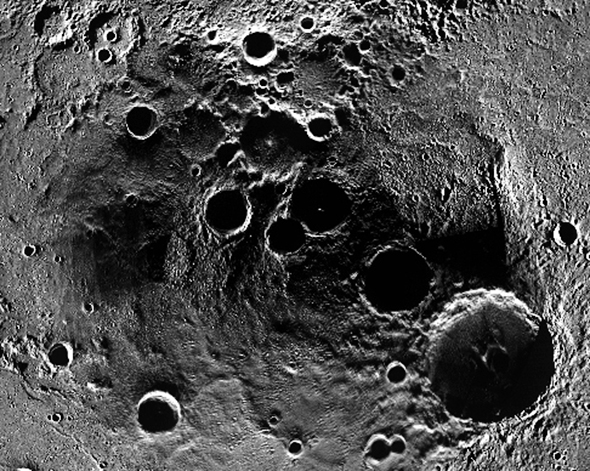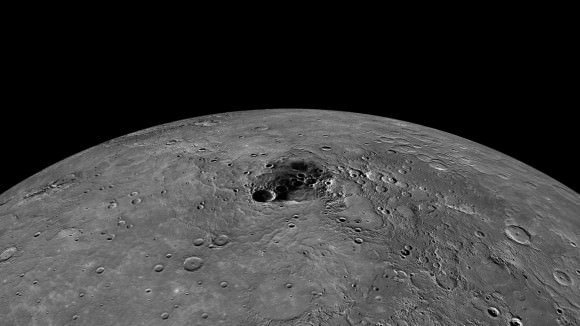Part of a stereographic projection of Mercury’s north pole
Talk about northern exposure! This is a section of a much larger image, released today by the MESSENGER team, showing the heavily-cratered north pole of Mercury as seen by the MESSENGER spacecraft’s Mercury Dual Imaging System (MDIS) instrument.
See the full-size image below:
Many MDIS images were averaged together to create a mosaic of Mercury’s polar region, which this stereographic projection is centered on. MESSENGER is at its lowest altitude as it passes over Mercury’s northern hemisphere — about 200 kilometers (124 miles), which is just a little over half the altitude of the ISS.
The largest centrally-peaked crater near the center is Prokofiev, named after a 20th-century Russian composer. Approximately 110 km (68 mi.) in diameter, its permanently-shadowed interior is home to radar-bright deposits that are thought to contain water ice.
Even though Mercury is almost three times closer to the Sun than Earth is and hosts searing daytime temperatures of 425ºC (800ºF), there’s virtually no atmosphere to hold or transmit that heat. Nighttime temperatures can reach as low as -185ºC (-300ºF), and since a day on Mercury is 176 Earth days long it gets very cold for quite a long time!
Also, because Mercury’s axis of rotation isn’t tilted like Earth’s, low elevation areas near the poles receive literally no sunlight. Unless vaporized by a meteorite impact any ice gathered inside these deep craters would remain permanently frozen.
Here’s an orthographic projection of the image above, showing what the scene would look like on Mercury — that is, if it was ever fully lit by the Sun, which it isn’t.
Many of the craters on Mercury’s north pole have recently been named after famous artists, authors and composers, such as Kandinsky, Stieglitz, Goethe, and even one named after J.R.R. Tolkien. You can see an annotated image showing the names of Mercury’s north polar craters here.
Read More: “The Hobbit” Author Gets a Crater on Mercury
On November 29, NASA will host a news conference at 2 p.m. EST to reveal new observations from MESSENGER, the first spacecraft to orbit Mercury. The news conference will be carried live on NASA Television and the agency’s website… you can tune in on NASA TV here.
Image credits: NASA/Johns Hopkins University Applied Physics Laboratory/Carnegie Institution of Washington




Mercury’s poles aren’t permanent, they are constantly moving from one place to another.
Its geographic poles or its magnetic poles? Not the same thing.
I’ve meant geographic poles.
I don’t believe those are moving around… Mercury’s axis isn’t even tilted.
Almost unbelievably it (Mercury) holds more ice water than the Moon. Great discovery.
We don’t know, how much ice water on poles of the Mercury or the Moon.
Those craters look like good places to hang out to avoid the radiation during an extended stay? Use the ‘cold trap’ in the crater shadow for energy generation with Sterling engines? Mining aps. on Mercury anyone? What minerals and metals are on or near the surface? What does the interior temperature gradient look like? Which crater has the best/deepest fracturing for mining?